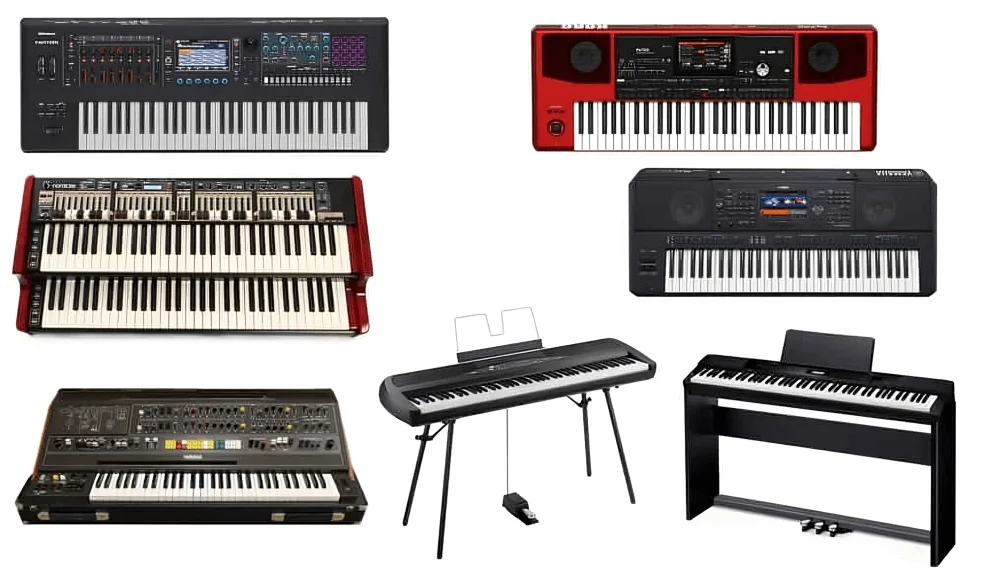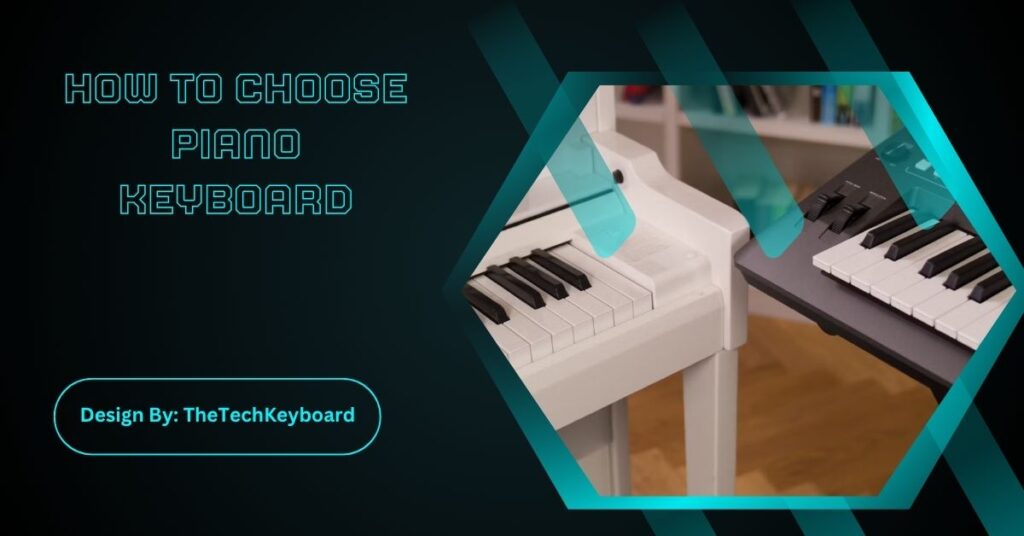Choosing a piano keyboard depends on your purpose, budget, and features like key count, weighted action, and sound quality. Beginners prefer portable 61-key models, while serious players opt for 88-key weighted digital pianos.
Choosing the right piano keyboard can be overwhelming. With so many models, sizes, and features available, beginners often struggle to decide which one suits their learning goals or performance needs. Whether you’re a first-time buyer or upgrading to a better instrument, selecting the right keyboard impacts how you learn, play, and enjoy music.
In this guide, we’ll explore factors to consider before buying, types of piano keyboards, and essential features to help you make a confident and informed decision.
Understand Your Purpose Before Buying
Before purchasing a piano keyboard, ask yourself why you need it:
- For Learning: Beginners need lightweight keyboards with learning modes and fewer keys.
- For Performing: Musicians require full-sized keyboards with realistic sound and touch sensitivity.
- For Composing/Recording: Producers prefer MIDI-compatible keyboards with advanced connectivity.
Understanding your purpose ensures you choose a keyboard that fits your current needs and future goals.
Types of Piano Keyboards

Different types of piano keyboards cater to various users:
1. Portable Keyboards
- Lightweight and compact
- Ideal for beginners or casual players
- Often includes built-in learning features and demo songs
- Usually ranges from 61 to 76 keys
2. Digital Pianos
- Closely replicate acoustic pianos in sound and feel
- Weighted keys for realistic playing experience
- Full 88-key range
- Perfect for students, home practice, or professional use
3. MIDI Controller Keyboards
- Primarily used for music production
- Requires connection to a computer or sound module
- No built-in speakers; depends on external software for sound
- Ideal for producers and composers
4. Stage Pianos
- Designed for live performances
- Focus on high-quality sound and portability
- Robust build to withstand touring
Key Considerations When Choosing a Piano Keyboard
1. Number of Keys
- 61 Keys: Great for beginners; lightweight and affordable.
- 76 Keys: A middle ground for learners wanting more range.
- 88 Keys: Full range; ideal for classical music and serious players.
2. Key Action and Touch Sensitivity
Key action determines how realistic the keyboard feels compared to an acoustic piano:
- Unweighted/Semi-weighted: Easier to press; good for children or casual play.
- Weighted: Mimics acoustic piano resistance; better for serious practice.
- Hammer Action: Best replication of real piano mechanics.
3. Sound Quality
- Look for high-quality samples recorded from real acoustic pianos.
- Consider polyphony count (number of notes playable simultaneously).
- For rich sound, choose 128-note polyphony or higher.
4. Portability and Size
- If you travel or have limited space, portable keyboards are ideal.
- Full-sized digital pianos are heavier but provide better playing experience.
5. Learning Features
For beginners, built-in features can accelerate learning:
- Lesson modes
- Light-up keys
- Metronome and recording functions
- Built-in song library
6. Connectivity Options
Modern keyboards offer various connectivity features:
- MIDI/USB ports for connecting to computers
- Bluetooth for wireless music apps
- Headphone jacks for silent practice
- Audio outputs for performances
7. Budget
Set a realistic budget based on your goals:
- Entry-level keyboards: $100 – $300
- Intermediate digital pianos: $400 – $800
- Professional stage pianos: $1,000+
8. Brand Reputation
Reputable brands offer better build quality and sound:
- Yamaha
- Casio
- Roland
- Korg
- Alesis
Beginner Tips for Buying Your First Piano Keyboard
- Start with 61 or 76 keys if you’re unsure about commitment.
- Look for touch-sensitive keys to learn dynamics properly.
- Choose a keyboard with built-in learning functions to reduce the need for external apps.
- Test the keyboard in-store if possible; check key feel and sound quality.
For Intermediate and Advanced Players
- Opt for 88 weighted keys for realistic practice.
- Focus on sound quality and key action over flashy features.
- Ensure the keyboard has audio outputs for stage or studio use.
- Check for layering and split functions to expand creative possibilities.
Digital Piano vs Keyboard: Which Should You Choose?
- Digital Piano: Best for serious players who want acoustic realism without the high cost or maintenance of a real piano.
- Keyboard: Great for beginners, portability, and casual practice.
If you aim to pursue classical or advanced playing, invest in a digital piano early.
Common Mistakes to Avoid

- Buying too few keys: 61 keys may limit you later if you advance quickly.
- Ignoring touch sensitivity: Dynamics are crucial for expressive playing.
- Overlooking polyphony: Low polyphony can cut off sustained notes.
- Not considering future goals: Buy a keyboard that can grow with your skill level.
Maintenance and Care Tips
- Keep your keyboard clean and dust-free.
- Avoid placing drinks near the keys to prevent spills.
- Use a padded bag for transport if portable.
- Update firmware (if applicable) for optimal performance.
Future Trends in Piano Keyboards
- Smart learning technology: AI-based feedback and app integration.
- Wireless connectivity: Bluetooth MIDI becoming standard.
- Compact yet powerful designs: Ultra-portable keyboards with full 88-key range.
- Hybrid models: Combining acoustic resonance with digital features.
FAQs:
1. How many keys should a beginner’s piano keyboard have?
Beginners often start with 61 or 76 keys because they are affordable, portable, and sufficient for basic learning. As skills improve, upgrading to an 88-key digital piano offers a full range for advanced practice and performance.
2. What’s the difference between weighted and unweighted keys?
Weighted keys mimic the feel of an acoustic piano, providing resistance for realistic dynamics and technique training. Unweighted keys are lighter, ideal for children or casual play but less suitable for advanced players seeking authentic touch response.
3. Do I need touch sensitivity in a beginner keyboard?
Yes. Touch sensitivity allows sound to respond to how hard you press keys, teaching dynamic control early. This feature prepares beginners for future transitions to acoustic pianos or professional digital pianos with advanced expression.
4. Which brands are best for piano keyboards?
Top brands include Yamaha, Casio, Roland, Korg, and Alesis. These companies are known for reliable build quality, realistic sound sampling, and beginner-friendly features across various price points, catering to students and professionals alike.
5. What features help beginners learn faster on keyboards?
Look for lesson modes, light-up keys, recording functions, and metronomes. These features guide rhythm, teach notes interactively, and let learners review progress, making practice engaging and efficient compared to basic models without learning aids.
Conclusion
Selecting the right piano keyboard depends on matching your skill level and musical goals with the right features. Beginners should prioritize portability, touch sensitivity, and learning tools, while advancing musicians benefit from 88-key weighted models with superior sound. Considering brand reliability, budget, and future growth ensures your keyboard remains useful for years. With thoughtful research and understanding key specifications, you can confidently invest in an instrument that supports your learning journey, enhances creativity, and encourages consistent musical practice over time.


